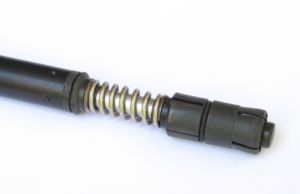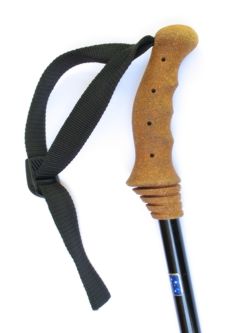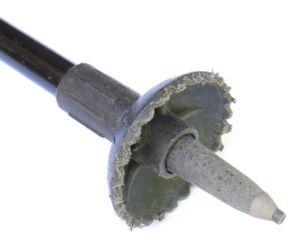Care and Maintenance
Generally the poles need very little maintenance, apart from regular cleaning with a dry cloth. Poles should always be stored in a clean and dry condition.
The tubes
Regularly clean and inspect the tubes for any damage. Unlock the locking devices and pull the lower sections out completely and detach from the upper section. Any traces of corrosion should be removed by rubbing with very fine sandpaper. Do not apply oil or grease to the pole tubes as this could cause the locking devices to fail.
The handle
Cork composite grips can be cleaned by wetting and rubbing with fine waterproof sandpaper and ordinary hand soap.
The straps can be replaced by unscrewing or removing the lock-pin in the top of the handle. Pay particular attention to the way the old strap is attached to the pin and replace the new strap the same way.
Locking devices
The twist lock systems do occasionally jamb. Do not use pipe grips or similar devices on the tubing when trying to free them. Any dents or bends in the tubes will usually render the pole unrepairable.
Pole tips
These are replaceable and are usually a press fit.
|
More about Trekking Poles
In this section we'll look at the various parts of the poles to help determine which best suits our needs.
The first thing to note is that trekking poles are used in pairs and should be purchased in pairs. Some shops sell trekking poles singly, but you will not get much advantage from a single pole and you may not be able to buy a matching pole at a later date.
The Shaft
The shaft of the pole usually consists of three telescopic sections of aluminium tubing that collapse into each other. A locking device on the lower two sections enables the length of the poles to be adjusted and fixed in position. Some poles have an anti-shock device fitted to the centre shaft.
The strength of the shaft is determined by the diameter and this is measured on the upper shaft. They come in sizes of 15mm to 18mm. The 18mm diameter tubing is the strongest, but also the heaviest. When choosing which one to buy, consider the weight of the pack you plan on carrying and also the terrain you are likely to encounter. As a general rule only go for the slimmer poles if your combined body weight and pack weight is less than 90Kg and you only plan to use the poles on easy terrain.
Trekking poles with carbon fibre shafts are appearing on the market, but as yet I have been unable to determine the performance characteristics of these poles.
|
 |
| An expander locking device mounted on top of a spring type shock absorber |
The locking devices
The most common device is the twist-lock system. Twisting the tubing operates an expander which locks the sections together. Although generally quite reliable, they can be difficult to operate with sweaty hands. Some manufacturers offer a flick-lock system.
Shock absorbers
A spring located in the centre shaft, below the locking device, is the usual form of shock-absorber, but some models have a pneumatic system. Shock-absorbers prevent jarring on the wrist and arms when walking on hard surfaces. However, they do this by absorbing some of the energy you apply to the pole. This energy loss is particularly noticeable when climbing steep hills. Most shock-absorber systems can be turned on or off as required. They are probably only required when walking on hard roads. |
 |
| Cork composite handle set at a 15 degree angle |
The handle
The handles are usually set forward at an angle of 15 degrees. This maintains the wrist in a near neutral position for most walking conditions. The flattened top of the handle allows users to push down with the flat of the hand for that extra bit of grunt when climbing over large tree trunks. The wrist-strap, fitted to the top of the handle, is adjustable. Some models have a strap that is broader on one side, where it slips under the heel of the wrist. These are left handed and right handed poles.
The grips are available in a choice of three different materials.
- Rubber is suitable for cold climates when gloves are worn. Not suitable for warm climates as it can be slippery in sweaty hands.
- Cork composite is suitable for warm and temperate climates. They may be used with or without gloves.
- Dense foam is more comfortable when used in hot climates, but is less suitable in wet weather.
Some manufacturers produce right and left handed poles; another reason why poles should always be purchased in pairs.
|
 |
| Tungsten carbide tip with basket attached |
The pole tip
The pole tip attaches to the bottom of the lower shaft and comes as a replaceable unit. The body of the tip has some degree of flexibility, to reduce the risk of breaking the pole if it gets jammed between rocks. Tips with tungsten carbide spikes on the end, are the most suitable for bushwalking. They will give maximum grip on slippery rocks.
Screw on baskets are available for use on soft ground. While most walkers leave the baskets attached to the poles, I personaly find them a bit of a nuisance and remove them when they are not required. The disadvantage in doing this is that I tend to lose the baskets. They can be purchased seperately and spares should be carried.
How to use trekking poles
Back to top |
| |



